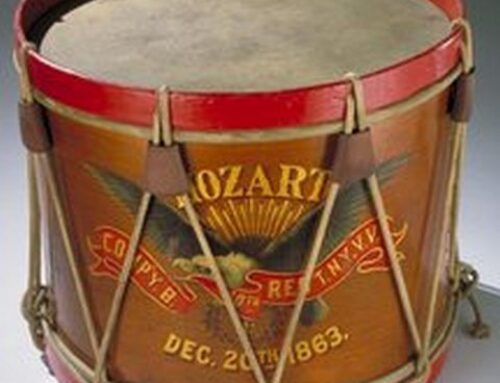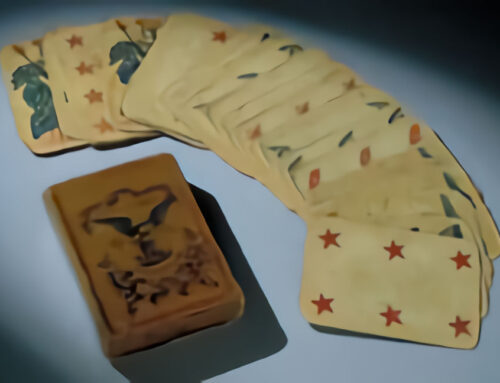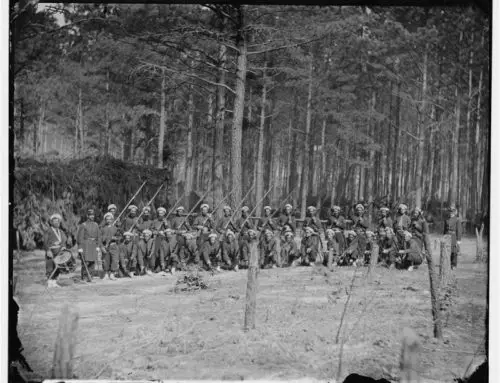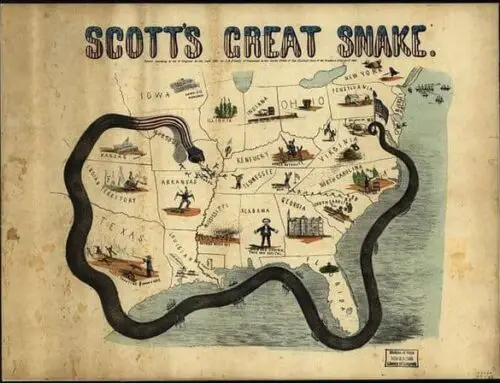Hardtack is a dense water cracker or biscuit made of water and flour (although salt was also common, albeit not always used). It was frequently found in military rations across European and American history.
Most famously, hardtack was used as a long-lasting food, able to withstand months or even years of storage. It was a staple in military diets, particularly by the navies of the 18th and 19th centuries, and soldiers of the Union and Confederate armies during the American Civil War.
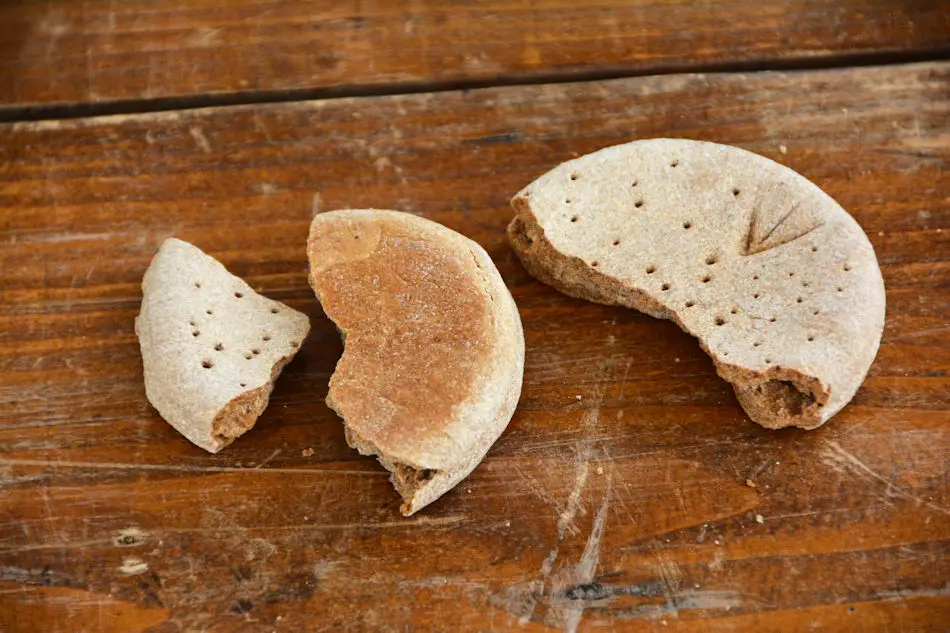
Hardtack
One of the most famous Union battalions in the Civil War was the 154th New York Volunteer Infantry Regiment out of Jamestown, New York. Made up of white Americans, Brits, Germans, other foreign troops, African Americans, Native Americans, and mixed-race soldiers, the Regiment served in some of the most important battles of the war from 1862 until 1865, including Chancellorsville, Gettysburg, Siege of Atlanta, and Sherman’s March to the Sea.
They were dubbed the “Hardtack” Regiment due to the frequent and devious trading of the biscuit for other goods and rations with the foreign members within the battalion who were less familiar with hardtack and its dubious reputation.
Why Is Hardtack So Hard?
Hardtack is hard because it is baked at least twice. It does not contain yeast and because of the holes in it, the dough is kept from expanding. After some time, the hardtack hardens even more, becoming drier and stale.
To Make About 12 pieces of Civil War Era Hardtack:
- Preheat your oven to 375°F.
- Mix 2 cups of all-purpose flour with about 2/3 cups of water and about 1½ teaspoon salt (if you want to be generous to the taste), adding flour as needed if the dough is sticky, water if too dry.
- Roll out on a floury, smooth surface until the dough is about half an inch thick.
- Cut into squares at about 3 inches.
- Poke holes in the 3×3 inch cracker with a knife, fork, chopstick, or skewer so it goes through to the other side (or repeat so there are holes on either side).
- Place on a baking sheet, bake for 30 minutes.
- Flip, bake for an additional 30 minutes (1 hour total).
- To make a more authentic British naval hardtack that was meant to last for several months on the rough seas, flip the hardtack again and bake for another 30 minutes, after which flip it once more, and bake for 30 more minutes (for a total of 2 hours in the oven, 1 hour per side).
- Remove from oven and place on a cooling rack for 20-30 minutes.
- Once cooled, pack away in an airtight container for days, weeks, months (depending on how authentic you feel like being).
Eating Hardtack
If you wish to consume, soak the hardtack for at least 20 minutes brine, coffee, tea, bacon grease, butter, water, milk, stew, soup, or any other liquid. If you do not wish to eat it soaked, you can break it with a meat mallet and sprinkle it over ice cream, porridge, sauces, meats, or any simple food of your choice. You can also mix it with other food, such as sugar, whiskey, hot water, and animal fat to make a pancake or various combination to make it more palatable.
Hardtack was the food of the common man, used throughout history and by many different navies and militaries across the globe as the go-to meals, alongside salted, dried, smoked, and cured meats and fruits, for its navy and soldiers before the use of canned food, C-rations, and MREs. It is currently used as food for emergency supplies during disasters and by survivalists and historical reenactors.
It is known that hardtack could be years old and used by sailors and soldiers through multiple conflicts and battles. American Civil War soldiers were fed hardtack that was left over from the Mexican American War (1846-1848), meaning the hardtack the Union and Confederate soldiers were eating were between 15-18 years old.
In the Spanish American War (1898), it was known that American sailors ate hardtack left over from the American Civil War, meaning the hardtack was between 33-37 years old!
Can Hardtack Stop a Bullet?
There are stories of it stopping a musket ball or bullet in battle, but much of this was colloquial anecdotes or wishful thinking, such as Civil War soldiers joking about making a vest made of hardtack to protect themselves.
In historical recreationist attempts, hardtack was shown to successfully stop pistol bullets, failing to pierce through the biscuit. That said, I would not recommend trying to wear hardtack as a defense against a bullet in a survival situation.
Can You Eat Hardtack Without Soaking It?
Hardtack can be broken up into small pieces and consumed that way without being submerged in liquids, although sometimes it can be incredibly difficult to chew on without soaking it. Some people chew on it, gnawing on it to loosen and soften it. That said, you could regret it if you try to eat it without soaking it.
Hardtack should not be, and traditionally is not, eaten without being soaked because of how dense it is. It is a really, REALLY, bad idea if you do attempt to eat it as it is such as biting a chunk of it off. Due to its nature of hardtack being such a rock-solid piece of food, you are much more likely to break, crack, or hurt your teeth, let alone make no progress with it.
How Do You Soften Hardtack?
The easiest way to soften hardtack is to submerge it into soup, coffee, stew, brine, or any other liquid of one’s choice for at least 20 minutes or more. Historically speaking, hardtack should be submerged in liquid for an hour before consumption.
Another way to soften hardtack would be to smash it into pieces and sprinkle them over other food, placed in a liquid, or cooked with other ingredients, such as whiskey, rum, hot water, or sugar to make a dessert or pancake.
Does Hardtack Last Forever?
Hardtack tends to last a long time, with instances of it lasting for years and through multiple conflicts, with hardtack from the Mexican American War being used as rations in the American Civil War, and Civil War hardtack showing up as food for the sailors of the Spanish-American War, and British sailors eating hardtack through the Napoleonic Wars that had been baked at the end of the 18th century after the American Revolution.
In museums, there are pieces of intact hardtack that are date back to the mid-19th century (over 160 years)! I would not recommend trying to eat one that old. As well, if you got an old or poorly stored piece of hardtack, you could get a portion infested with weevils and maggots. While it might add protein to your nutrition, it is rather unappetizing to think about, especially since hardtack was the go-to staple of most meals in the military diet.
Is Hardtack Any Good?
Hardtack, at best, tastes like a bland cracker that may or may not be made of chewy cardboard, long forgotten about that you found in the back of your cupboard. Around the time of the Civil War hardtack tended to be baked in two versions. The first was done in the infantry style (30 minutes per side), and the other was the naval version (1 hour per side). I would have rather served in the infantry than the navy if the deciding factor was based solely on which hardtack I would prefer to eat. In short, not great.
According to historical documentation, hardtack was vital but not well liked by anyone who had to consume it. Sailors and soldiers dealt with infestations of weevils in their biscuits and had to soak their biscuits in their rum, coffee, tea, or whiskey to remove the bugs from their hardtack just to be able to prepare it for consumption.
During the American Civil War, soldiers would sing “Hardtack Come Again No More,” to the tune of Stephen Foster’s “Hard Times Come Again No More” to joke about the food, including lyrics of how the hardtack was “old and very wormy” and made their “stomachs sore.”
What Is Like Hardtack?
The most similar food to hardtack would be crackers, twice baked bread, bread, biscotti, or rusks. All hard, long lasting, bland, and filling.
When Was Hardtack First Made?
There are references to hardtack and its derivatives throughout human history. It is believed early, primitive peoples, once they had begun farming, started making sustainable foods of cereals and grains. In ancient Egypt, the sailors carried a millet loaf called dhourra cake which was made of cereals or grains.
In Ancient Rome, soldiers carried biscuits called bucellatum as a part of their rations, which was made of different flours, grains, or cereals, water, salt, and butter or lard. In the Crusader period of the 11th-13th centuries, muslin biscuits are referred to as a staple of the Crusader diet. British sailors, from the 16th century on up into early 20th century, all consumed hardtack as a major part of their standard diet.
Why Was Hardtack Called Hardtack?
Hardtack gets its name from the humorous commentary on the ration’s rigidity and British naval vernacular term for food, tack.
Hardtack has had many different monikers, often descriptors of the biscuit, including molar breakers, worm castles, army crackers (Russian), tooth dullers, armor plates (German), jawbreakers, army wafers (Polish), dog biscuits, and sheet iron. Other names for hardtack include ship’s biscuit, sea biscuits, soda crackers, cabin bread, pilot bread, and brewis.
There are stories of soldiers during the American Civil War using the butts of their rifles to break the hardtack into pieces before being soaked or cooked.

